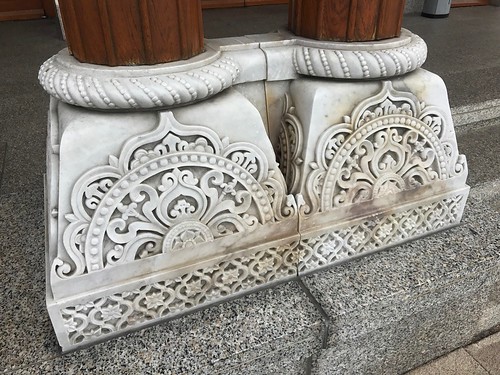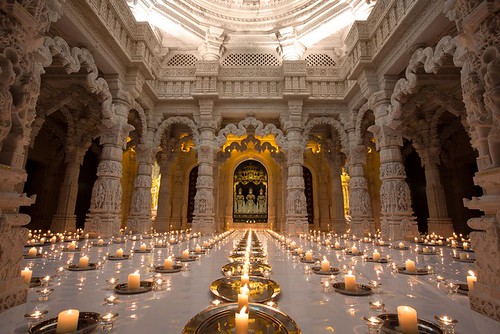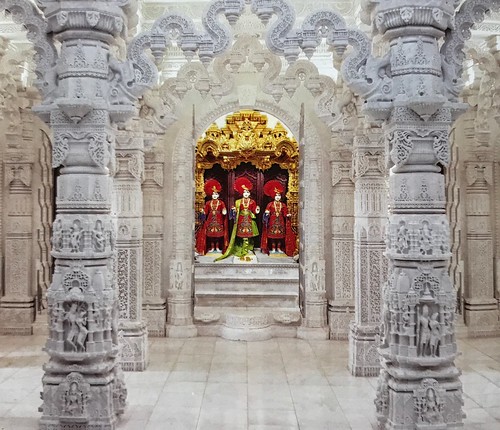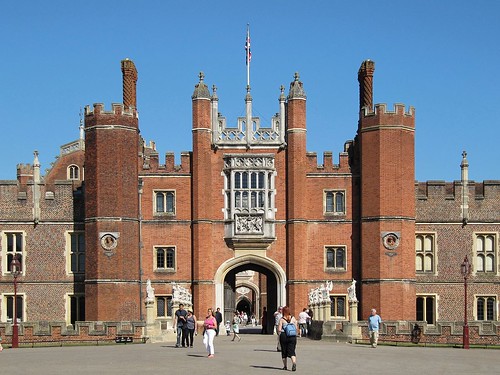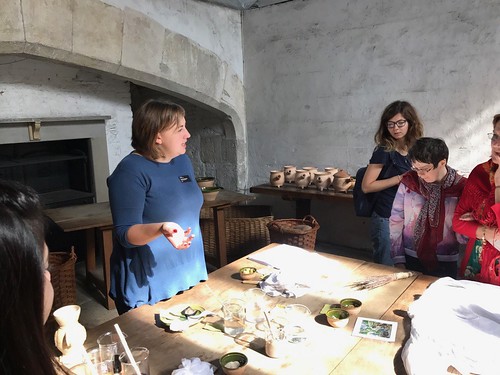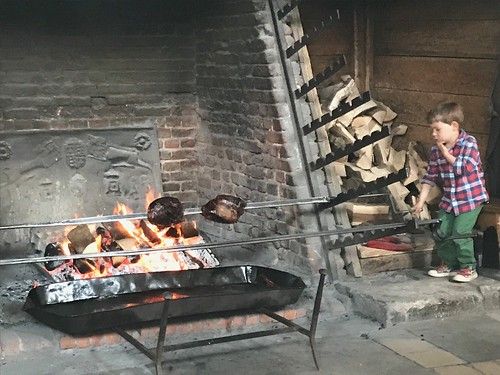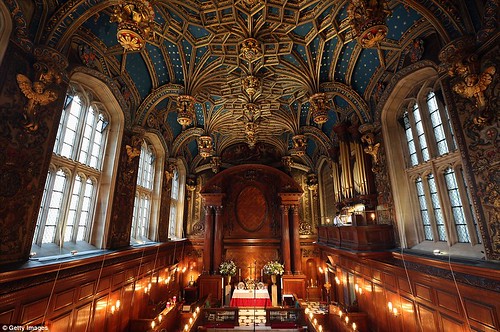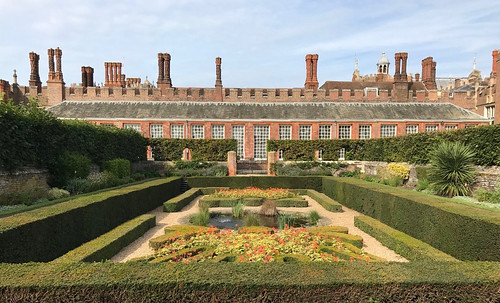There are a lot of things you expect to find in the suburbs of northwest London: Wembley Stadium. Ikea. The North Circular. Street after street of mostly unremarkable houses. What you emphatically don’t expect to find is a huge, opulent Hindu temple made from white marble.
I’d been vaguely aware of the existence of the temple, but only because I’d walked past it on the long trek to Ikea (Of course.) It’s surrounded by high walls so while might have thought, “Hmmm, that’s quite large” not much more than that really sunk in to my brain. For me to really stop and appreciate the site I needed the assistance of The Intrepid Raul who Astute Go Stay Work Play Live Readers will remember from various Bakuvian adventures, including frozen waterfalls and mountains on fire. Raul recently returned to UK soil after a three year exile contract in Azerbaijan and suggested the visit when we were catching up over a curry. I was keen on this idea partly because Raul is a pleasant companion, but also because he’s got the distinct advantage of growing up in a bi-cultural household where he might spend Sunday mornings at church then proceed to temple for the afternoon, which he claims seemed perfectly normal. In any case, I was not going to pass up the chance to see the temple with a somewhat native guide, so we agreed to meet one Tuesday at Stonebridge Park Underground for the short walk to the site.
And now, a little terminology and history. “Mandir” simply means temple, and this particular temple was the first traditional Hindu temple in Europe (being the first purpose-built traditional stone building, as opposed to an adapted pre-existing structure.) The BAPS Shri Swaminarayan Mandir - to give it its full name - is part of the BAPS organisation. (And BAPS stands for Bochasanwasi Akshar Purushottam Sanstha so let’s continue to use the abbreviation, shall we?) BAPS is a global Hindu organisation within the Swaminarayan branch of Hinduism, based, unsurprisingly, on the teachings of Swaminarayan. And here, with great relief, I revert to Wikipedia:
But it gets better! The construction of the temple was accomplished largely with volunteer labour. Volunteers. 3,000 of them. Assembling huge chunks of stone. And they finished the building in just 3 years. There was a quite long explanatory video in the basement museum area that showed miles of footage of the construction including lots and lots of presumably unskilled people manoeuvring 26,300 one-of-a-kind chunks of richly carved marble into position. That wasn’t a disaster waiting to happen at all. Luckily, the video didn’t mention any horrific crushing injuries or disfiguring tragedies. Not even a single shot of someone scratching their head over a plan in front of a vast field of almost identical bits of stone and shouting despairingly in Hindi something like, “Sanjay! Check that one over there! Is that 21,335 or 21,334?"
Raul and I fetched up at the temple complex on a grey Tuesday afternoon, where I checked my bag across the street in a poratkabin and we went through the mandatory metal detector. First we visited the Haveli, the community centre sort of building I mentioned earlier.
Swaminarayan Mandir - at the time of its construction in 1995 it was the largest Hindu Temple outside of India. (Photo credit: original uploader was Nikkul at English Wikipedia)
And now, a little terminology and history. “Mandir” simply means temple, and this particular temple was the first traditional Hindu temple in Europe (being the first purpose-built traditional stone building, as opposed to an adapted pre-existing structure.) The BAPS Shri Swaminarayan Mandir - to give it its full name - is part of the BAPS organisation. (And BAPS stands for Bochasanwasi Akshar Purushottam Sanstha so let’s continue to use the abbreviation, shall we?) BAPS is a global Hindu organisation within the Swaminarayan branch of Hinduism, based, unsurprisingly, on the teachings of Swaminarayan. And here, with great relief, I revert to Wikipedia:
"Swaminarayan (3 April 1781 – 1 June 1830), also known as Sahajanand Swami, was a yogi, and an ascetic whose life and teachings brought a revival of central Hindu practices of dharma, ahimsa and brahmacharya. He is believed by followers as a manifestation of God.”The temple is London is remarkable for many reasons. It was, as I’ve mentioned, the first purpose-built Hindu Temple in Europe. More remarkably, it was built according to “ancient Vedic Architectural texts” meaning that no structural steel was used. The main temple building is constructed from almost 5,000 tonnes of Bulgarian limestone, Italian Carrara and Indian marble. All the stone was cut and shipped first to India, where it was hand-carved by more than 1,500 different artisans. Then each stone was numbered and carefully packed and shipped to the site in London where each of the more than 26,000 pieces was assembled. Like I said - remarkable.
A close-up of some of the stone carving outside. And this is just a relatively restrained bit on the sort of “church hall” building called a Haveli, not the temple itself.
Raul and I fetched up at the temple complex on a grey Tuesday afternoon, where I checked my bag across the street in a poratkabin and we went through the mandatory metal detector. First we visited the Haveli, the community centre sort of building I mentioned earlier.
Raul and the Haveli from the outside. The decorations above the door were in preparation for Diwali;, the annual Hindu Festival of Light, crudely analogous with Christmas.
Housing a large prayer hall, gymnasium, library, day care, office and gift shop (with all the incense you could ever need) the Haveli is also ornately carved but made mostly from English oak and sustainably harvested Burmese teak.
Here's a close up of some of the carved wood on the outside. Understated it is not. Apparently for every oak tree they cut down in construction they planted ten oak saplings somewhere in Devon. Nice.
No photos are allowed inside the buildings of the temple complex, but I did manage to sneak this one after I took my shoes off, a requirement of visiting.
Guess which ones are mine?
We had a quick look around the Haveli, though the largest rooms weren’t open to the public. Then we walked the long corridor linking the Haveli with the actual Mandir. And as impressive as the mandir is from the outside, it’s much much more impressive on the inside.
Here’s an interior picture I scooped up from Google that shows the room with candles lit for Diwali. The roof is a huge dome, supported by the columns and the serpentine supports between the columns. It really is amazing.
And here you can see a close up of some of the carvings on the support columns. The depth and detail is astonishing. Every column is carved like this.
The upper sanctum houses seven shrines that contain sacred figures of Deities that are normally hidden behind large doors. At appointed times through the day the doors are opened and the figures - called murti - are revealed so that worshippers can pray, meditate and participate in devotional ceremonies. (We didn’t see that happen, though I recall I did see this in a temple in India.) I had a lot of questions, and it would have been great to consult with Raul about the meaning and purpose of a lot of the things in the room, but there was a very strict NO TALKING policy, with a stern looking elderly gentleman there to keep order, so we just padded around quietly in our sock feet and I itched to take photos, and I didn’t.
And a close up of another set of murti from the mandir.
I did find one thing funny. Throughout the temple complex there were donation boxes; that’s not unusual in any religious institution. However, the BAPS gang are savvy and modern enough that they actually had contactless payment systems set up at some boxes! Want to donate at the murti of Ganesh? Embarrassingly out of change or small bills? No problem. Just tap your phone! £1 per tap. For some reason I found this funny and disturbing at the same time.
Once we finished in the sanctum I elected to pay £2 to visit the exhibition on Understanding Hinduism in the lower level of the mandir. This was a small but extensive and densely informative look at the history and tenets of Hinduism, and at the Swaminarayans and this mandir in particular. Hinduism is an ancient and diverse religion. I was surprised to learn that it's generally considered the oldest major religion in the world that's still practised, predating not just the Roman Empire, but even Ancient Egypt. Sanskrit, the primary language of Hinduism, is the oldest Indo-European language, and Hinduism claims the world's first university (from 700 BC, a teaching subjects as diverse as logic, grammar, medicine, astronomy, commerce, music and dance). The exhibit also credits Hinduism, or ancient Indian culture in general, with inventing the zero, geometry, and the Pythagorean Theorem (before Pythagorus), and with discovering the heliocentric nature of the solar system and gravity, and developing plastic surgery. Busy beavers.
The Swaminarayan Mandir really is remarkable. Raul and my visit was not long, but the whole time I kept hearing him muttering, "You could be in India." It was a bit like someone had lifted up the Great Pyramid at Cheops and settled it gently in a carpark in Swindon. Coming back out into the grey Tuesdayness of north London after visiting was a bit of a shock. Which made my next destination all the more jarring. Where did I go? After being deeply immersed in ancient eastern culture and architectural wonder?


